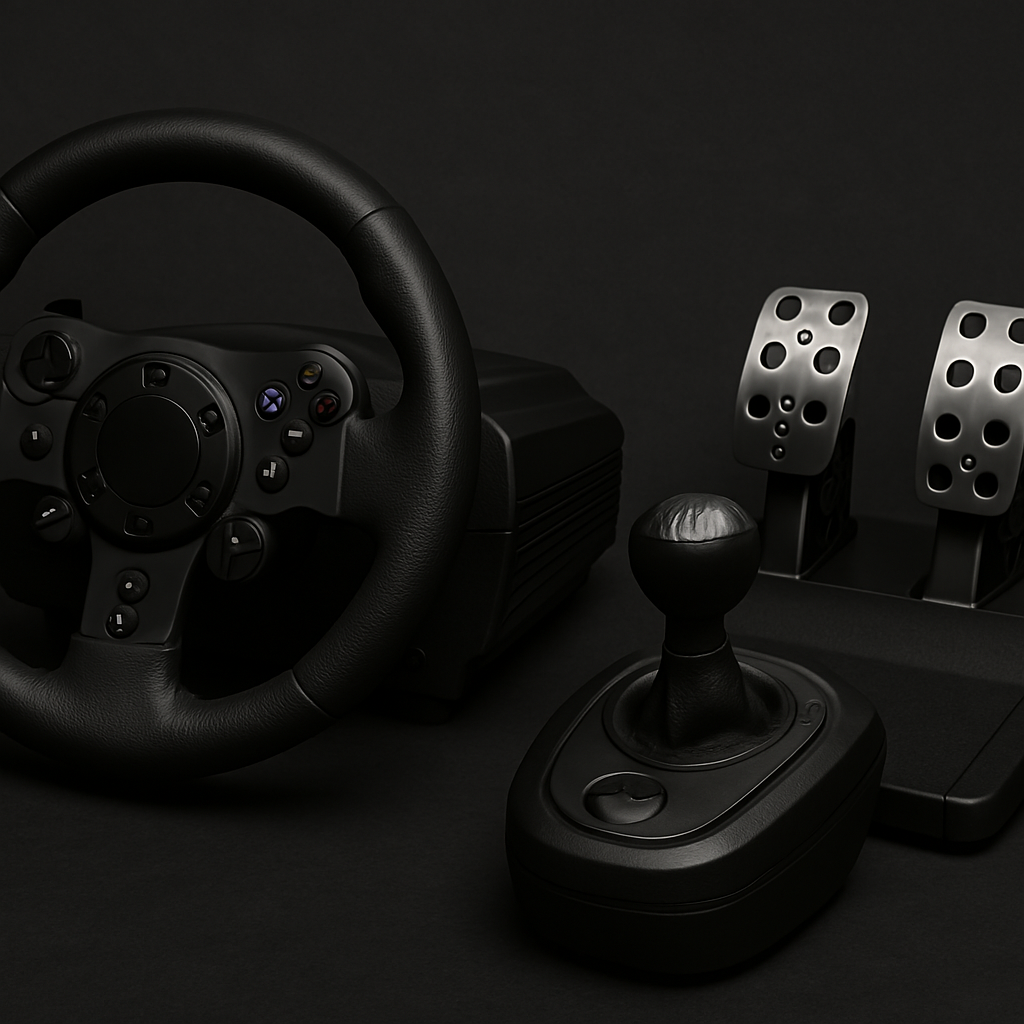
Introduction: What Is Sim Racing, and Why Should You Care?
Sim racing—short for simulation racing—is far more than a video game. It’s a high-intensity, adrenaline-fueled hobby that mimics the precision, physics, and strategy of real-world motorsport. Whether you’re dreaming of racing at Spa-Francorchamps or tackling time trials at Laguna Seca, sim racing gives you the tools, immersion, and feedback to experience it all—without ever leaving your home.
But here’s the challenge: the world of sim racing can feel overwhelming when you’re starting out. There are dozens of gear choices, platforms, and opinions flying around in forums and Reddit threads. That’s where Sim Rig Zone comes in—we cut through the noise and show you exactly how to get started, what to buy (and avoid), and how to level up as a virtual racer.
Let’s hit the track.
Why Sim Racing Is Exploding in 2025
Sim racing is no longer a niche. Thanks to the rise of eSports, better hardware accessibility, and the real-world racing crossover (many pros now train using sims), the hobby has exploded globally.
Here’s why sim racing continues to gain traction:
Immersion rivaling real motorsports: Today’s force-feedback wheels, high-end pedals, and VR support allow for realism that rivals actual track driving.
Global online competition: With platforms like iRacing and Assetto Corsa Competizione, you can compete with thousands of other racers worldwide—any time of day.
Affordability & scalability: Unlike karting or track days, sim racing lets you race daily with no fuel costs, no tires to replace, and no garage required.
Real-world crossover: Real F1 drivers like Max Verstappen and Lando Norris actively train in simulators. Sim racers like Igor Fraga have even made the leap into real-world racing.
What You Need to Start Sim Racing
Let’s break down every core component of a sim racing setup, from absolute essentials to optional upgrades for later.
1. Your Platform: PC or Console?
This is your first major decision—and it determines what games, accessories, and communities you’ll have access to.
PC: The Most Flexible, Powerful Option
Compatible with almost every sim racing title (including iRacing, rFactor 2, Automobilista 2, Assetto Corsa)
Supports modding, custom liveries, and community-created content
Offers better graphics, smoother framerates, and extensive gear compatibility
Ideal for: Racers looking for a long-term, customizable experience with access to the most competitive platforms.
Console: Simple & Affordable
Easy plug-and-play setup with games like Gran Turismo 7 (PS5) or Forza Motorsport (Xbox)
Limited to console-compatible gear
Fewer hardcore sim titles, but still immersive
Ideal for: Beginners on a budget or casual players who already own a console.
Pro Tip: If you can afford it, start with PC. It’s the gold standard for sim racing and gives you room to grow.
2. Sim Racing Software: Choosing the Right Game
Your choice of sim racing title affects your experience just as much as your gear. Here’s a breakdown of the most popular platforms:
iRacing
Subscription-based with laser-scanned tracks and real-world physics
Unmatched online competition, with licensed races and rankings
Ideal for serious racers who want structured leagues and realism
Assetto Corsa (and Competizione)
AC: Highly moddable, great community, massive car/track database
ACC: Official GT3/GT4 simulator with stunning visuals and competitive realism
Perfect for both casual and competitive racers
rFactor 2
Used in professional driver training
Complex physics engine and great for endurance racing fans
Steeper learning curve, but extremely rewarding
Gran Turismo 7 (PS5) / Forza Motorsport (Xbox)
Accessible, beautiful, and controller-friendly
GT7 leans more into simulation than arcade; Forza is more casual
Great entry point if you’re not ready for a full rig setup
3. Sim Racing Hardware: The Heart of Your Rig
a. Racing Wheel
This is the cornerstone of any serious sim racing setup. Force feedback lets you feel every bump, slide, and weight transfer.
Beginner Options:
Logitech G923 – Affordable, reliable, includes pedals, decent force feedback
Thrustmaster T248 / T300 RS – Stronger feedback, belt-driven, solid mid-tier choice
Enthusiast & Pro:
Fanatec CSL DD – Direct Drive at an affordable price
Simucube 2 Sport – Industry-grade performance for the most demanding racers
Direct Drive vs Belt Drive: Direct drive wheels offer pure, powerful force feedback directly from the motor. Belt drive uses pulleys—less sharp but more affordable.
b. Pedals
Never underestimate your pedals. Proper throttle control and trail braking rely on pedal feel.
Key features to look for:
Load Cell Brake – Measures actual pressure, not distance = more realism
Adjustable tension – Tune the resistance to your driving style
Top Picks:
Thrustmaster T-LCM – Load cell at a budget price
Fanatec CSL Pedals + Load Cell Kit – Modular and pro-level accuracy
c. Shifters & Handbrakes (Optional)
Shifter: Adds realism, especially for manual racing and rally stages
Handbrake: Essential for drift/rally drivers
Popular options: Thrustmaster TH8A, Fanatec Clubsport Shifter SQ
4. Mounting Solutions: How to Build a Stable Rig
You don’t need a full cockpit from day one—but mounting matters.
Budget-Friendly
Clamp your wheel to a sturdy desk
Use office chairs with locking wheels or swap them for rubber feet
Wheel Stands
Freestanding, foldable, stable
Great for small spaces
Example: Next Level Racing Lite, GT Omega Apex
Full Sim Cockpits
Steel/Aluminum frames, racing seat, adjustable arms
Immersive and rock-solid
Brands: Next Level Racing, Playseat, SimLab
A cockpit doesn’t just look cool—it lets you brake harder, turn sharper, and drive longer without discomfort.
5. Visuals: Monitors vs VR vs Triple Screens
Single Monitor
Most affordable
24″–32″ works fine to start
Triple Monitors
Massive field of view
Requires a strong GPU and monitor mounts
VR (Virtual Reality)
Deepest immersion possible
Demands powerful PC and tolerance to motion sickness
Top Picks: Meta Quest 3, HP Reverb G2, Pimax Crystal
6. Recommended Accessories
Racing Gloves: Improve grip and extend wheel life
Gaming Chair or Racing Seat: Long sessions need lumbar support
Button Boxes: Customize controls without keyboard reliance
Motion Platforms / ButtKicker: Take immersion to the next level
Sample Beginner Builds (2025)
Here are some example setups based on different budgets:
| Setup | Gear | Estimated Cost |
|---|---|---|
| Entry-Level | Logitech G923, Desk Clamp, Monitor | ~$350 |
| Starter Rig | Thrustmaster T248, Wheel Stand, Entry Pedals, 27″ Monitor | ~$700 |
| Mid-Range | Fanatec CSL DD, Load Cell Pedals, Cockpit, Single Monitor or VR | ~$1,500–$2,000 |
| Pro-Level | Simucube 2 Sport, Hydraulic Pedals, Aluminum Rig, Triple Monitors + VR | $3,500+ |
Tips for New Sim Racers
Start slow. Focus on technique over speed. Fast lap times come with time.
Use practice modes. Get used to car physics, braking points, and throttle control.
Watch YouTube tutorials. Channels like Ermin Hamidovic, Dan Suzuki, and Jimmy Broadbent are packed with value.
Join a league. Online communities like SimGrid, LFM, and iRacing leagues will make you better faster.
Upgrade smart. Focus first on pedals and ergonomics—don’t blow your budget on aesthetics.
Conclusion: Sim Racing Is Just Getting Started
Sim racing isn’t just a substitute for real-world driving—it’s a discipline of its own. With the right approach, you’ll build not only a killer sim rig but real skills that translate into precision, patience, and competition.
Here at Sim Rig Zone, we’ll walk with you every step of the way—from your first lap to your first podium. So buckle up, shift into gear, and prepare to join the grid.
